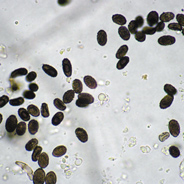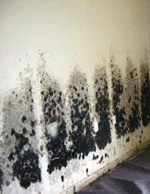
What Is Black Mold? Stachybotrys chartarum
Media sensationalism has caused a great deal of fear about black mold. But not all black molds are toxic, and not all “toxic molds” are black. So, what is black mold?
Toxic black molds

Stachybotrys chartarum and Aspergillus niger are 2 of the black molds that are toxic (toxigenic), ie., they produce mycotoxins. These two black molds may be found growing in moisture damaged buildings.
Symptoms of Mold Exposure
Individuals sensitive to molds may experience symptoms such as nasal stuffiness, eye irritation, wheezing, or skin irritation when exposed to molds. Severe reactions may include fever and shortness of breath. Exposure to black mold does not always present a health problem unless the person exposed to black mold is immunocompromised.
Stachybotrys chartarum is the infamous black mold initially associated with respiratory distress and the deaths of infants in Cleveland, Ohio in the 1990’s. When wet, Stachybotrys looks greenish black and slimy, but can also look sooty and black. It’s been associated with a number of symptoms some of which are highly controversial, including inflammation of the skin, cough, running nose, nose bleeds, a burning sensation in the mouth and nasal passage, cold and flu symptoms, headache, general fatigue, and fever. It may also cause pathological respiratory changes.
Aspergillus niger is dark gray to black, looks dry, and is very different from Stachybotrys. Health effects associated with Aspergillus niger include allergy and infection of the respiratory system especially in individuals with weak immune system.
Non-toxic black molds

But there are many other types of black mold that are not toxic at all, although they could be allergenic. The most common is Cladosporium, which normally has no known toxic side effects. Cladosporiumis common both inside and outside.
Most of us come in contact with Cladosporium every day with no ill effect at all. Symptoms from heavy exposure are usually an increase in allergy and asthma symptoms.
Other molds that may appear black include Ulocladium, Stemphylium, Pithomyces, Alternaria, Dresclera, and Aureobasidium. None of these are known to produce highly potent mycotoxins; therefore, none of these are toxic molds but some such as Alternaria can cause severe allergy symptoms.
For a more detailed descriptions on various household molds, see common indoor molds.
If you need to know whether the black mold in your home is toxic or allergenic, send a sample and have our laboratory identify it for you. We’ll let you know whether it’s toxic or not, what type of symptoms are associated with your house mold sample, and how to get rid of it safely and completely.
Latest posts by Jackson Kung'u (see all)
- Symptoms of mold exposure - September 4, 2015
- Mildew and Moisture in Homes - September 3, 2015
- Mould Removal - September 2, 2015
